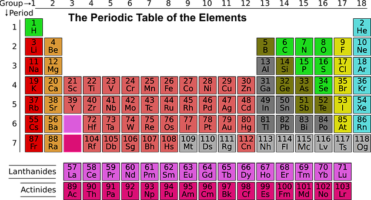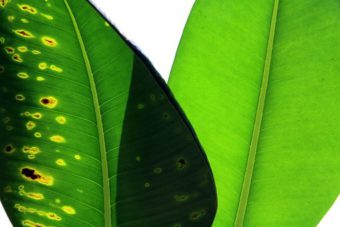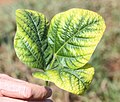In this article, we will be discussing the right nutrients that each plant requires to be at their healthiest. We all know that plants need certain elements to grow to their optimal in producing the greenest leaves, most colourful blooms and the most abundant fruits.
There are 118 known elements in the periodic table (some are artificially made) and the majority of these elements are not required by plants to flourish. In fact, only 6 elements are required in large quantities, whilst the other 17 are required in much lower quantities. Some elements are only required in such small quantities that they are crucial for plant survival but are not required in large amounts at all.

In containers, plants will not grow properly or flourish if they are not given the right nutrients and at the right quantities. Usually in the garden, they are taken from the soil, but in containers, this is not readily available, so may need to be added to give the plants the best chance of survival.
This is where slow-release fertiliser, soluble liquid fertilisers, soil improvers and various other fertilisers that need to be added. Plants also get their nutrients from the air that surrounds it and the water that falls as rain, and water that is applied via watering cans and hoses.
HOW DO PLANTS GET THEIR NUTRIENTS?

From the leaves, plants absorb carbon dioxide and sunlight to allow photosynthesis to occur, where carbohydrates are produced. To help with this via the roots, nutrients are absorbed, along with water and air that surrounds it and in the roots, will allow the plant to flourish. The plant gets its energy from the carbohydrates that it forms.
Plants need 4 types of nutrients to survive: structural nutrients, primary macronutrients, secondary macronutrients and micronutrients (or trace element as they are more popularly known as). Plant nutrients also fall into a 5th category but this will be explained later.
STRUCTURAL NUTRIENTS
The structural nutrients consist of carbon, hydrogen and oxygen that are obtained from the air that surrounds the plant and the water the plant uptakes. They are known as structural nutrients as they help to build the building blocks of plant life- cellulose. This keeps plants strong and upright. The nutrients take part in the photosynthesis process to produce sugars that are turned into cellulose.
PRIMARY MACRONUTRIENTS
There are three essential nutrients that a plant needs to survival; Nitrogen (N), Phosphorous (P) and Potassium (K). These essential elements are often obtained from the soil the plant is placed in. This is the NPK ratio often stated on the side of fertilizer packaging.
SECONDARY MACRONUTRIENTS
Sulfur (S), Calcium (Ca) and Magnesium (Mg) are the next important elements. They are still required by the plant but not as in large qualities as nitrogen, phosphorous and potassium. Soil often do not lack these nutrients, especially if it has been limed. This is because lime often consists of calcium and magnesium carbonates. Sulfur can be obtained from sulfates in the soil, especially if it contains gypsum (Calcium sulfate).
MICRONUTRIENTS (Trace Elements)
These nutrients are only required in minuscule qualities by the plants. In that the plants need the element to survive but not in large qualities than primary and secondary macronutrients. These include Boron (B), Copper (Cu). Manganese (Mn), Iron (Fe), Zinc (Zn) and Chlorine (Cl)
NON-ESSENTIAL ELEMENTS
There is another category of elements that are useful but are not essential at all. What is meant by this are elements that plants can use if the element is present, but it is not required for the plant to survive. The plant will only use the element if they can find them in the soil, otherwise, they will be happy without it. This includes Aluminium (Al). Silicon (Si), Selenium (Se), Sodium (Na), Vanadium (V), Nickle (Ni) and Iodine (I).
WHAT DOES EACH ELEMENT DO?
STRUCTURAL NUTRIENTS
Carbon– It is used by the plants in photosynthesis to produce sugars in the plant. It is obtained from carbon dioxides in the air that surrounds the plant. If not enough carbon is obtained by the plant, it will not produce enough food or energy and the plant will simply die.
Hydrogen- This element like carbon is used by the plant to build up sugars during photosynthesis. It is obtained via the water the plant receives. Without hydrogen, the plant cannot produce sugars and the plant dies.
Oxygen- This is received by the plant to convert sugars it produces and converts it to energy. Oxygen comes from the air that surrounds the plant and from the water that the plant uptakes. It is highly unlikely that a plant will lack oxygen.
PRIMARY MACRONUTRIENTS

Nitrogen- This is used by the plant to produce the green leaves, new growth and wellbeing of the plant. It comes from the soil and fertilisers that are found at the roots of the plant. Legumes such as peas and beans produce nodules that fix nitrogen from the atmosphere and convert it in the plant itself. Many plants take up nitrogen in the form of nitrates. If a plant lacks nitrogen the plant stops growing and the leaves start turning yellow starting at the bottom.

Phosphorous- This element stimulates healthy roots in the plants and to ensure that it grows at a healthy rate. This element is normally obtained from the soil and fertilisers that are added to the soil, normally in the form of phosphates. A lack of phosphorous cause the roots to be underdeveloped and the leaves start turning purplish, starting from the bottom.

Potassium- This promotes the formation of blooms, along with its colour, flavours and resistance to disease. It is often found in soils and the fertilisers that are added to it. A classic sign of deficient is the yellowing and spotting of the lower, older leaves.
SECONDARY MACRONUTRIENTS
Sulfur- This element promotes the formation of chlorophyll, and in the root growth and helps in determining how vigorous the plant grows, along with how hardy it can be. It is mainly obtained from the soil, but can also be obtained from fertilisers added to the soil and through rainfall. A deficiency in sulfur will result in yellow leaves and spindly, weak growth.

Calcium- This element is a component in the formation of the plant cells wall structure. It also strengthens the plants and t is often found in the soil by the use of lime, gypsum and supersulfates. A deficiency of calcium will cause the plant to yellow at the most active sections of the plants such as the leaf tips and can cause blossom end rot of fruit.

Magnesium– This element is important in the formation of chlorophyll and therefore important in helping photosynthesis. It is mainly found already present in the soil, or it can be added via fertiliser such as Epsom salts and by adding lime. A deficiency of this element can be noticed by the leaves starting to turn yellow between the veins.
MICRONUTRIENTS (Trace Elements)

Iron- This is another important element in the development of the photosynthesis of the plants, as it helps in the production of chlorophyll. It is often found present in the soil but can be added via fertiliser such as sulfate of iron. Any deficiencies that are found can cause yellowing around the edges of the leaves.

Zinc- This element controls and regulates how the plant consume and manufactures sugars. This is often found present in the soil but can be added via fertilisers. If this element is lacking it will cause leaves to be malformed and/or fruit to be distorted.
Manganese-This element helps in the breakdown of sugar in the plant, to help produce energy. This element is not commonly missing from soils, but if it is it can be added via fertilisers. A deficiency in this element is quite similar to a deficiency in magnesium, where the leaves start turning yellow between the veins.
Copper- This helps the growth of the plant and how the sugars are metabolised. It is often found already present in soils but any deficiency can be dealt with by adding suitable fertilisers to the soil. A lack of this element will start to turn the upper leaves yellow.

Boron- This element is used along with calcium in the cell wall synthesis in making the plants sturdy. It is essential for cell division in the production of new plant cells. Boron is very important for reproduction growth, as it helps with pollination, fruit and seed development. It is obtained from the soil or it can be added via specialised trace element fertilizers. A lack of boron results in the lack of cells being reproduced and in the reduction of plants being fertilized. This is a common deficiency that is easy to treat.
Chlorine is an important element in plant photosynthesis, as it is involved in the opening and closing of pores in the leaves that enable the plant to take in and release carbon dioxide, oxygen and other gases. It also ensures that the leaves are firm. It is obtained via the soil the plant is placed in and by using trace element fertilisers added to the compost. Too little chlorine will cause the plant to wilt because of the inadequate venting system. It causes the leaves to become mottled and chlorosis to appear.
Nickel is a trace element that is found in some plant enzymes, most notably urease that helps in the production of ammonia within the plant. Without nickel toxic levels of urea can accumulate within the leaf causing areas of the leaves to die.
NON-ESSENTIAL ELEMENTS
Aluminium promotes the uptake of nutrients. Too much aluminium can cause aluminium toxicity that limits plant growth, especially in acidic soils. Aluminium is needed in small amounts for root production; too much and fewer roots are formed. Nitrogen, phosphorous and potassium uptake is increased with small amounts of aluminium, but too much and it will be toxic to the plants. You will find this element in soils and so will not be required any additional supplement to be made.
Silicon in soils and compost improves the plant’s ability to tolerate delay in watering. In some plant, silicon can aid the resistance and help metal reduce metal toxicity. It also helps to make the plant resistant to stress. Silicon can be generally found in soil and so there is no need to add it. Too much silicon can interfere with the uptake of other nutrients the plants require and cause deformity.
Selenium has similar properties to sulfur. It helps with plant growth and tolerance to certain stresses. It can repel pests in reducing their growth or by poisoning them. Excess selenium can cause the plant to grow thinly and may help to develop chlorosis and die.
Iodine is not a crucial element for plants on land, but in aquatic plants, it plays a role in antioxidant metabolism.
Cobalt is a trace element, but it is not essential to plant life. As an element, it is found in several enzymes and will increase the drought resistance of seeds.
Sodium has a role in plants to help in the metabolism and synthesis of chlorophyll. Although it is not essential at all.
Vanadium increases the concentration of amino acids, sugars and chlorophyll and modifies other nutrients’ concentration. It therefore helps and modifies the plant development and growth.
We have talked about helpful elements that have a positive role in the plant’s health. You have also seen that some elements in excess can be harmful to the plants in question, and may even cause death.
ELEMENTS THAT ARE BAD FOR PLANTS
Two elements are particularly bad for plants and should be avoided as much as possible.
Cadmium- This can affect the uptake of nutrients and so should not be added to the soil at all.
Lead.-This will inhibit seed germination, root growth, seedling development, plant growth, transpiration, chlorophyll production, water and protein content. A real plant nasty.
CONCLUSIONS
In this article, the right nutrients that plants require has been discussed. There are 23 element to which a plant can use. Some are very important, whilst others not so much so.
You can see that plants need various elements at the right concentration that must be supplied via the soil it grows in, the water that is supplied, and the air that surrounds it. All elements have a specific use and role in plant chemistry, and the plant must get a regular supply of them.
An often forgotten aspect of nutrients for plants is the role of non-essential elements, as they are used by plants when they are valuable to them. If they are not available then the plant will quite happily do without them. There are many nutrients required but we can say that 16 elements are essential for plants survival.
If you are to do well, you must provide these 16 elements. I will be talking about trace elements fertilizers in a forthcoming article.
You now know what it takes to have a healthy plant in your containers and your garden. If you have any questions or comments that you wish to make, please do so in the comment box below.
Get your nutrients right.

Hi Antonio!
Thanks for another great post!
I really did not know that my plants required so many nutrients. Now my question is, most of those elements are found in the soil or fertilizer, what should I do if my plants show signs of lacking some nutrients? How can I fix it?
Because my aloe plants are having some spot on the leaves, yet I am using a fertilizer that claims to have all the nutrients you have listed above.
Thanks
Hi Adyns
I thank you once again for stopping by and commenting. It is amazing the amount of nutrients that plants need in order to survive and flourish. To answer your question is that you need to use a general-purpose fertiliser in order to supplier the nutrients and this is why I have written a lot of articles on this subject. You can use slow release fertiliser for a slow feed or a liquid fertilizer for a quick boost.
Yellow spots are not always a sign of deficiency but could be due to improper watering or light conditions.
Hope this helps
Antonio
Thank you very much for sharing about elements. This reminds me of my experience when studying biology and chemistry in my high school. I’ll make sure to check if the important nutrients are included for our garden care. Just a small question, Do you know where we usually find Cadmium and Lead, so we can avoid it? Thanks for your explanation
Hi Alblue
I will tell you a secret chemistry was my favourite subject in school. I believe it is important to tell gardeners the important elements taht plant need in large quanties and those required in small quantities. Most soils will not have cadmium and lead in them and so you will not need to worry. I put that in to make people aware of the problems they cause.
Thanks
Antonio
Hi, thanks for sharing this amazing article about giving your plant the right nutrients. Reading your article has made me understand the most essential element needed for plant to grow and also it has made me to know the element that are not needed in much quantity. It also have made me understand that lack of this essential nutrients can cause damage to the plant such as yellowish of leaves . But please i have a question. There are some plants that do have a reddish colour like aloe vera plant. What is the cause of it.
Hi PrettySophia
Thank you very much for your comment as I believe it is important to inform the public of what is required to get the best from plants. Most plants deficiency indeed has yellowing of the leaves but it is often assumed that plant leaves are green. This is incorrect because some plant indeed have red, purple or grey leaves and this is caused by a pigment in the leaves, it is not a sign of disease but a natural alternative to the green observed in a lot of plants. Hope that answers your question.
Thanks
antonio